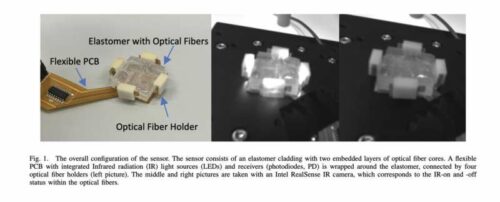Researchers have developed a new tactile sensor that can detect the properties and characteristics of surrounding objects just like humans.

For robots to work efficiently, they must be able to recognize and detect the properties and characteristics of objects in their surroundings, so that they can grasp and manipulate them accordingly. Humans naturally achieve this using their sense of touch and roboticists have thus been trying to provide robots with similar tactile sensing capabilities.
Researchers at the University of Hong Kong have developed a new soft tactile sensor that could allow robots to detect different properties of objects that they are grasping. Based on the principle that contact force can be derived from the light power loss in the soft optical fiber core, this soft tactile sensor decouples normal and shear forces and calibrates the measurement results based on the object size They designed a two-layered weaved polymer-based optical fiber anisotropic structure embedded in a soft elastomer.
Basically, the sensor produces an anisotropic response when it is deformed in different directions. This response is then processed by a linear calibration algorithm, which directly maps the signals emitted by the optical fibers to the size of the object in contact with the sensor and the forces calibrated to the object’s size.
Researchers tested their sensor in a series of real-world experiments, integrating it at the tip of a robotic arm. In these initial tests, the sensor achieved very promising results, as it could measure the size of objects and their normal and shear forces calibrated by their size with good accuracy.
“By calibrating the sensor at the robotic arm tip, we show that robots can reconstruct the force vector at an average accuracy of 0.15N for normal forces, 0.17N for shear forces in X-axis , and 0.18N for shear forces in Y-axis, within the sensing range of 0-2N in all directions, and the average accuracy of object size measurement of 0.4mm, within the test indenter diameter range of 5-12mm,” said Wentao Chen, Youcan Yan in their paper.
Compared to other artificial tactile systems developed in the past, the researchers’ soft sensor does not rely on data-driven artificial intelligence (AI) models, which can be computationally demanding and often require significant training. This makes it easier to implement on a large-scale, since its fabrication process is also relatively easy and low-cost.
Reference : Wentao Chen et al, Polymer-Based Self-Calibrated Optical Fiber Tactile Sensor, arXiv (2023). DOI: 10.48550/arxiv.2303.00619






